One of the most remarkable painters to capture the autumn landscapes of Alberta was William LeRoy Stevenson (1905–1966). In our latest artist feature, learn about the groundbreaking career of this leading Calgary Modern artist.
In 1954, William LeRoy Stevenson reached a pivotal crossroads in his artistic career. That summer, he left his job with the Canadian Pacific Railway and, after eight years in Vancouver, moved home to Calgary. On his return, he decided he would focus on art full time, teaching classes and developing his practice as a painter.[1] To mark his new direction, he presented a solo exhibition at Coste House, then the home of the city’s Allied Arts Centre. In the catalogue for the show, he offered a concise summary of his artistic goals, declaring, “I believe that each new painting should give the artist a new visual problem” such that no matter the subject of the painting, the artist creates “a work of art whose quality lies in the interplay of tonal contrasts and the relationships of color and form, all brought together in a satisfying unity to give the painting its own unique character.”[2] As the new artistic chapter in his life began, the visual problem that intrigued him most was landscape.
Stevenson had grown up in Calgary, and as a young man decided on a career in accounting. By the time he was in his early twenties, however, he was also committed to art, and to Modern art in particular. This became the foundation of his friendship with the artist Maxwell Bates, whom he met at the Calgary Public Library around 1926. The two men were introduced to each other by Harry Hunt, the secretary of the Calgary Art Club, and they quickly began sharing artworks, art books, and magazines with each other. As Bates recalled, “our meetings became sessions for discussion and evaluation. It was not long before I began to do watercolors that I could show him, and I was always anxious to see anything he had done.”[3]
Both Stevenson and Bates aspired to study art beyond Calgary but could not afford to do so, so they planned holiday trips instead, visiting Vancouver and Victoria in 1928 and Chicago in 1929. Later in life, Stevenson stated, “A visit to the Chicago Art Institute…to see firsthand some of the better examples of the great moderns left an intense impression on me.”[4] He saw this as the beginning of his artistic development and was deeply inspired by Paul Cézanne and Vincent van Gogh.[5]
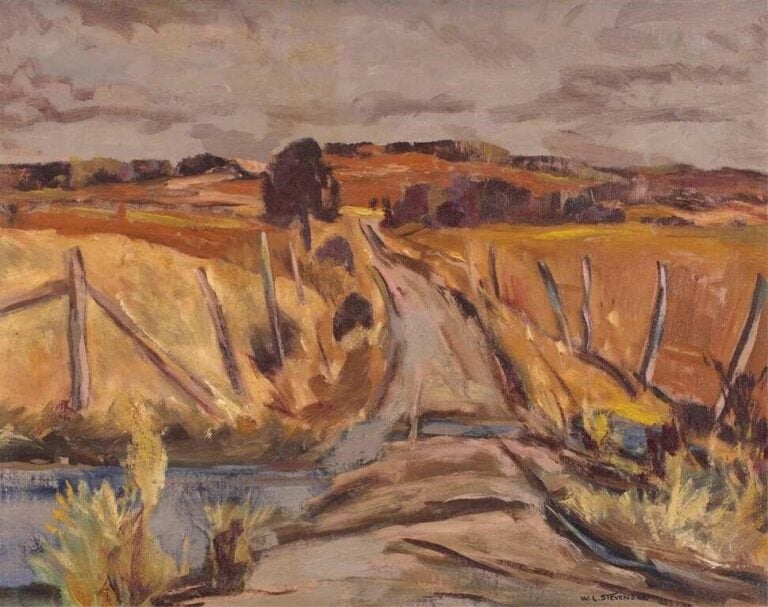
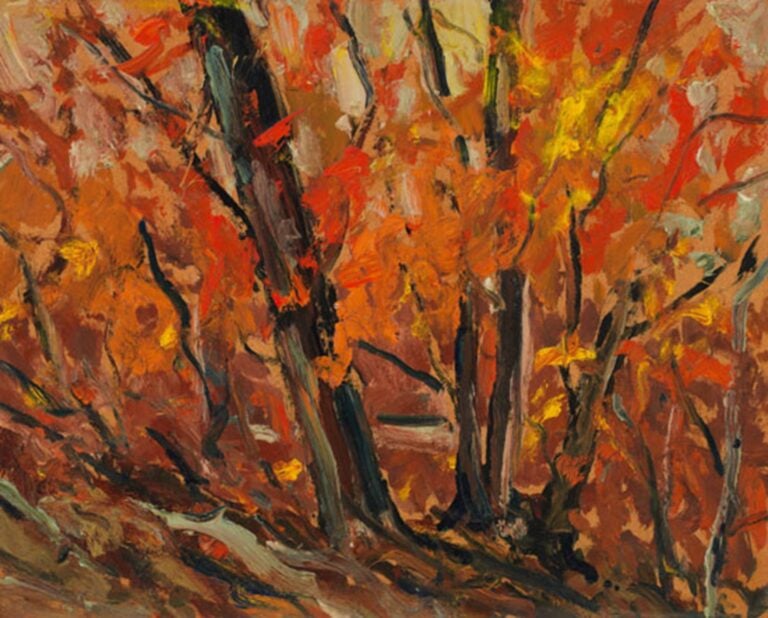
Modern landscapes were among the first paintings Stevenson exhibited. In 1929, he exhibited an oil painting titled Autumn with the Ontario Society of Artists and then with the Calgary Art Club.[6] A review in the Calgary Herald praised his work as “warm in colouring and powerful in construction,” and commended him for recognition from “Canada’s leading art societies.”[7] But in the early years of his career, Stevenson experimented with a wide range of subjects, including portraits and figurative compositions, urban buildings and street scenes, and still life paintings of fruit, flowers, and objects. It was the still life works that attracted attention in his 1954 exhibition; the Calgary Herald claimed they were the best paintings in the show.[8]
Choosing to shift his focus to landscape was a strategic move on Stevenson’s part, but it was also one that reflected his passions. He knew landscape paintings might sell better; critics speculated collectors might be drawn to places he painted because the landscapes would resonate with individual memories of the region around Calgary.[9] Independent of commercial opportunity, Stevenson had more personal motivations. In reflecting on his practice, he noted, “I like being outside as much as possible.” He was interested in painting moods at different times of the year; he was also drawn to foothills, lakes, sloughs, and bush country rather than the mountains.[10] He preferred to teach outdoors, and felt “if a person can paint a tree they are well on their way” (not surprisingly, trees were an important subject in his own work).[11]
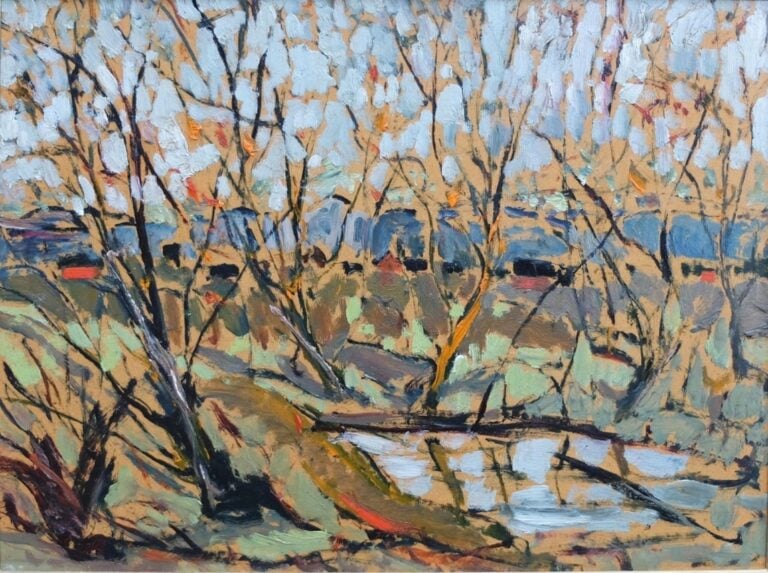
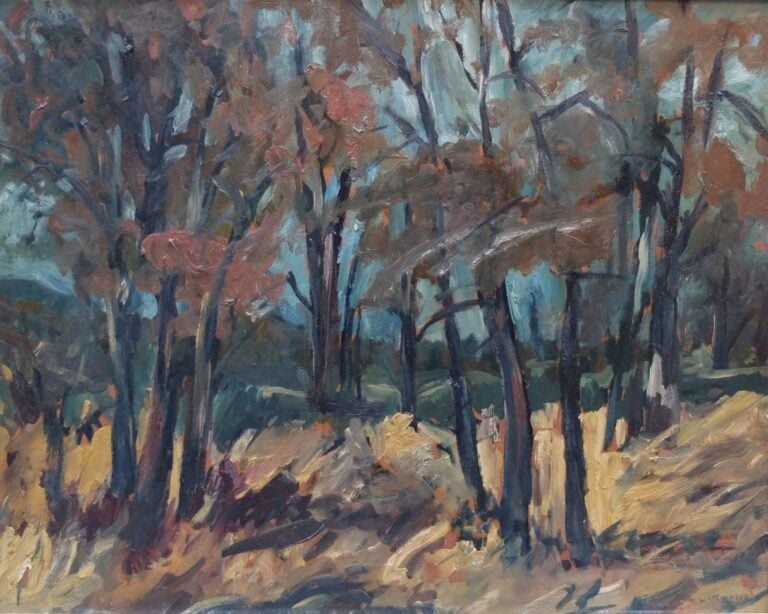
Stevenson quickly became known for painting landscapes that captured seasons. While many of his works’ titles refer to a specific season or month, autumn was especially important to him. He was interested in every aspect of the season, from the soft lights of lingering dawns and twilights to the cold, damp atmosphere of early snowfalls. He painted trees in autumn in many states, sometimes emphasizing the bright golds and deep rusts of changing leaves, as in Autumn, and sometimes capturing the delicate branches of trees already completely bare, as in September Morning. Some of Stevenson’s most high-profile paintings were images of autumn; for example, in 1958 he submitted October Morning to the Canadian Group of Painters’ annual exhibition. Then, after contributing to several major group exhibitions in the late 1950s, Stevenson had a series of solo shows, and autumn landscapes emerged as one of his most important themes. At his 1962 solo exhibition at the Calgary Allied Arts Centre, 11 out of the 17 paintings shown were autumn landscapes. One of these works was Autumn Snow (Touches of Snow Among Autumn Foliage in Foothills); Glenbow purchased this painting from the exhibition and it became the first work by the artist to enter Glenbow’s collection.
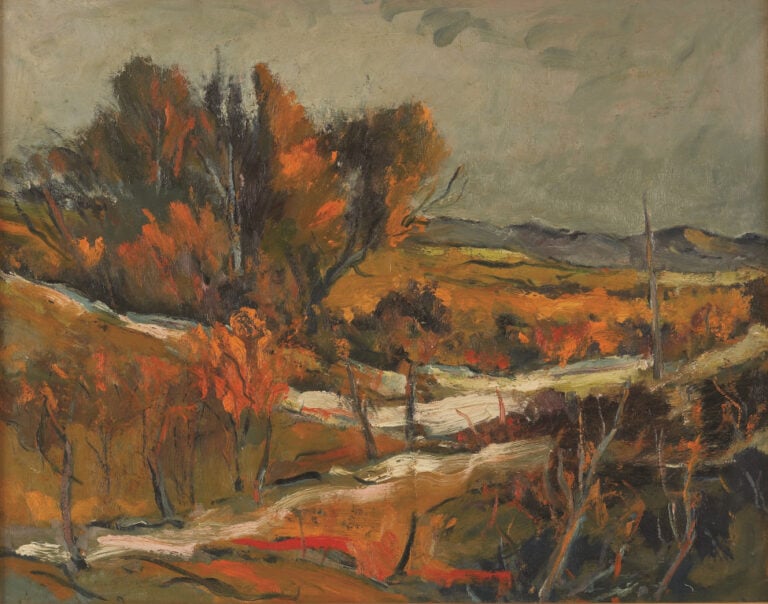
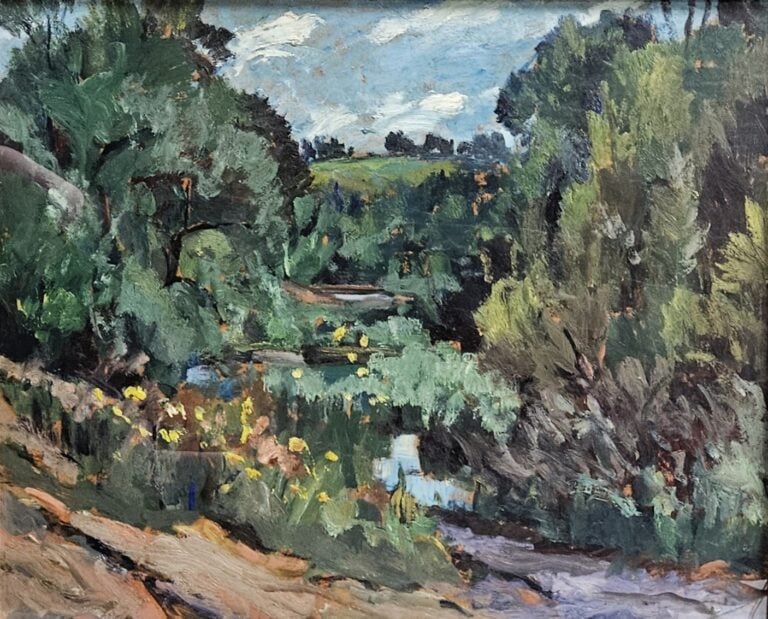
In the early 1960s, Stevenson’s art received unprecedented critical attention, and many were interested in his unique approach to landscape. Writing for the Calgary Herald, Robin Neesham reported, “Mr. Stevenson attempts to capture the ‘mood’ of a scene in his painting, and he is very conscious of the passage of time, both within a 24-hour period and of the seasons…he still goes into the wilds of southern Alberta, and most usually in the area south of Calgary to find his inspiration.”[12] Edmonton critic Dorothy Barnhouse proclaimed, “This artist appears to work swiftly, even casually, but examination reveals a carefully calculated underlay of rich glazes which act as a foil for the surface brush work. Often the natural brown of the Masonite ground acts as a unifying element as well. He is a master of the windy sky and the moving branch.”[13]
The most important national recognition Stevenson ever received appeared in the March-April 1963 issue of Canadian Art, the county’s most prominent visual arts magazine. As a special feature in this issue, the famous American critic Clement Greenberg had been invited to conduct a survey of artists in Western Canada. In his comments about landscape painting in Calgary, Greenberg began his discussion with Stevenson, stating, “My discovery among landscape painters in Calgary was W. L. Stevenson…I had the good fortune to see a show of Stevenson’s at the Focus Gallery in Edmonton, and can’t understand why he is not known all over Canada.”[14] Stevenson’s painting On Prince’s Island was reproduced on the cover.
Stevenson’s work in landscape ended suddenly in the midst of this success. He died in a car accident in December 1966, leaving behind dozens of paintings, finished and unfinished. His brother, Gerry Stevenson, became responsible for his artistic legacy, and gradually many paintings were collected by leading museums in Alberta. Today, Stevenson is known for his commitment to art at a time when there were few opportunities for artists in this province, and he is admired for a dramatic body of work that captures the distinctive topography of Alberta and the unique energy of its changing seasons.
References
[1] “Former Calgary Artist Returns,” Calgary Herald, August 27, 1954.
[2] Catalogue: A Coste House Exhibition (Calgary: Coste House, September 1954), n. p.
[3] University of Calgary, Maxwell Bates Fonds, 439/89.1, 10.2, “The Painter W. L. S.: A Memoir,” 3 – 4.
[4] Exhibition of Four Alberta Artists: Bates, Mitchell, Stevenson, and Kiyooka (1956): n. p.
[5] Robin Neesham, “Painting ‘Mood’ Held Important By Artist Now Holding Showing,” Calgary Herald, July 12, 1963.
[6] “Varied Subjects Shown in Art Club Exhibit,” Calgary Albertan, May 31, 1929.
[7] Doris Parrott, “Art Collection Matter of Pride for Calgary City,” Calgary Herald, June 6, 1929.
[8] “Still Life Paintings to Be Shown,” Calgary Herald, September 11, 1954.
[9] “W. L. Stevenson Has One-Man Show,” Calgary Albertan, July 6, 1963.
[10] “Art Students Take Lessons in Landscape Oil Painting,” Red Deer Advocate, July 10, 1965.
[11] Rosemary Wood, “Outdoor Classes Find Popularity at Coste House,” Calgary Herald, July 26, 1957.
[12] Neesham, “Painting ‘Mood’ Held Important By Artist Now Holding Showing.”
[13] Dorothy Barnhouse, “Stevenson Reverses Procedure – First a Critic, then a Painter,” Edmonton Journal, October 7, 1964.
[14] Clement Greenberg, “Clement Greenberg’s View of Art on the Prairies,” Canadian Art XX, no. 2 (March/April 1963): 100.
